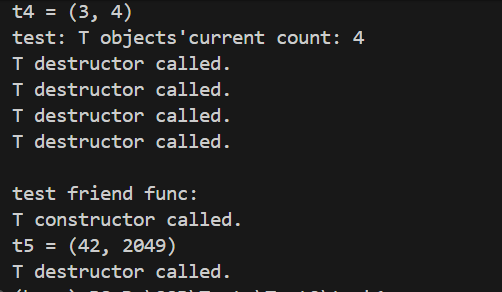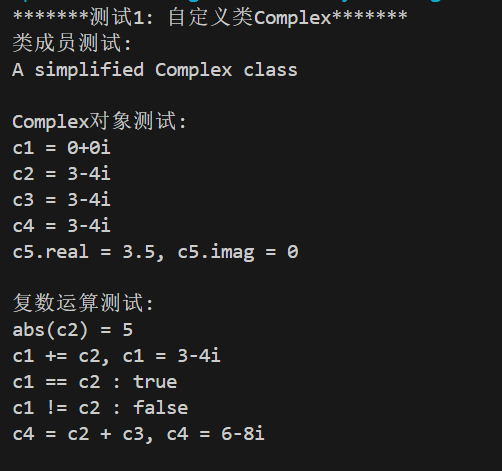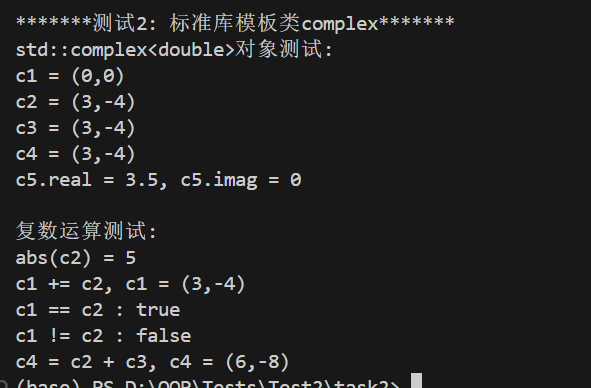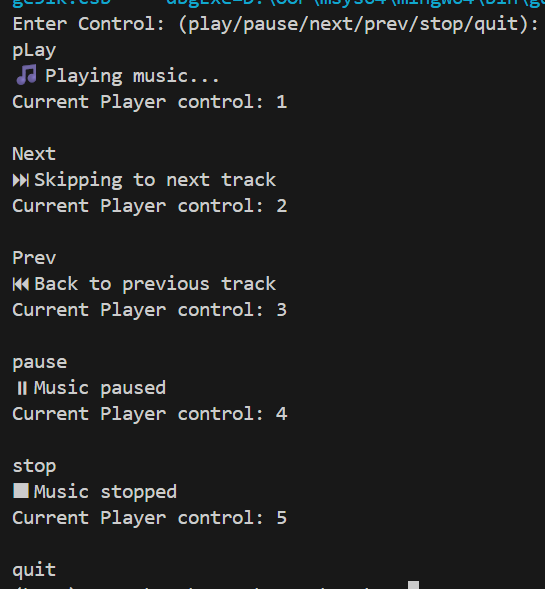Test2
任务一
源代码
T.h
点击查看代码
#pragma once
#include <string>
// 类T: 声明
class T
{
// 对象属性、方法
public:
T(int x = 0, int y = 0); // 普通构造函数
T(const T &t); // 复制构造函数
T(T &&t); // 移动构造函数
~T(); // 析构函数
void adjust(int ratio); // 按系数成倍调整数据
void display() const; // 以(m1, m2)形式显示T类对象信息
private:
int m1, m2;
// 类属性、方法
public:
static int get_cnt(); // 显示当前T类对象总数
public:
static const std::string doc; // 类T的描述信息
static const int max_cnt; // 类T对象上限
private:
static int cnt; // 当前T类对象数目
// 类T友元函数声明
friend void func();
};
// 普通函数声明
void func();
T.cpp
点击查看代码
#include "T.h"
#include <iostream>
#include <string>
// 类T实现
// static成员数据类外初始化
const std::string T::doc{"a simple class sample"};
const int T::max_cnt = 999;
int T::cnt = 0;
// 类方法
int T::get_cnt()
{
return cnt;
}
// 对象方法
T::T(int x, int y) : m1{x}, m2{y}
{
++cnt;
std::cout << "T constructor called.\n";
}
T::T(const T &t) : m1{t.m1}, m2{t.m2}
{
++cnt;
std::cout << "T copy constructor called.\n";
}
T::T(T &&t) : m1{t.m1}, m2{t.m2}
{
++cnt;
std::cout << "T move constructor called.\n";
}
T::~T()
{
--cnt;
std::cout << "T destructor called.\n";
}
void T::adjust(int ratio)
{
m1 *= ratio;
m2 *= ratio;
}
void T::display() const
{
std::cout << "(" << m1 << ", " << m2 << ")";
}
// 普通函数实现
void func()
{
T t5(42);
t5.m2 = 2049;
std::cout << "t5 = ";
t5.display();
std::cout << '\n';
}
task1.cpp
点击查看代码
#include "T.h"
#include <iostream>
void test_T();
int main()
{
std::cout << "test Class T: \n";
test_T();
std::cout << "\ntest friend func: \n";
func();
}
void test_T()
{
using std::cout;
using std::endl;
cout << "T info: " << T::doc << endl;
cout << "T objects'max count: " << T::max_cnt << endl;
cout << "T objects'current count: " << T::get_cnt() << endl
<< endl;
T t1;
cout << "t1 = ";
t1.display();
cout << endl;
T t2(3, 4);
cout << "t2 = ";
t2.display();
cout << endl;
T t3(t2);
t3.adjust(2);
cout << "t3 = ";
t3.display();
cout << endl;
T t4(std::move(t2));
cout << "t4 = ";
t4.display();
cout << endl;
cout << "test: T objects'current count: " << T::get_cnt() << endl;
}
实验结果

测试结论
问题1:T.h中,在类T内部,已声明func()是T的友元函数。去掉line36,重新编译,程序是否能正常运行?如果能,回答YES;如果不能,以截图形式提供编译报错信息,说明原因。

答:
YES(dev-c)。
NO(vscode)。

原因:未找到func()声明。
问题2:T.h中,line9-12给出了各种构造函数、析构函数。总结它们各自的功能、调用时机。

答:
1.T(int x = 0, int y = 0)用给定的参数初始化新的对象,含有默认参数,无参数传入就默认构造;一般在直接定义时调用。
2.T(const T &t)用一个已经存在的对象复制给一个新对象;一般在左值初始化时调用。
3.T(T &&t)用一个将亡对象构造一个新对象;一般在右值初始化时调用。
4.~T()对象生命周期结束时进行资源释放;一般在对象被销毁或失去作用时调用。
问题3:T.cpp中,line13-15,剪切到T.h的末尾,重新编译,程序能否正确编译。如不能,以截图形式给出报错信息,分析原因。

答:
YES(dev-c)。
NO(vscode)。

原因:头文件 T.h 里定义了静态数据成员,这个头又被多个.cpp 同时包含,导致每个翻译单元各自生成一份同名符号,链接时冲突。
任务二
源代码
Complex.h
点击查看代码
#include <string>
class Complex
{
public:
Complex(float x = 0, float y = 0);
Complex(Complex &t);
~Complex();
float get_real() const;
float get_imag() const;
void add(Complex t);
static std::string doc;
private:
float real, imag;
friend void output(const Complex &t);
friend float abs(Complex t);
friend Complex add(Complex t1, Complex t2);
friend bool is_equal(Complex t1, Complex t2);
friend bool is_not_equal(Complex t1, Complex t2);
};
Complex.cpp
点击查看代码
#include "Complex.h"
#include <iostream>
#include <cmath>
std::string Complex::doc = "A simplified Complex class";
Complex::Complex(float x, float y) : real(x), imag(y) {}
Complex::Complex(Complex &t) : real(t.real), imag(t.imag) {}
Complex::~Complex() = default;
float Complex::get_real() const { return real; }
float Complex::get_imag() const { return imag; }
void Complex::add(Complex t)
{
real += t.real;
imag += t.imag;
}
void output(const Complex &t)
{
std::cout << t.real << (t.imag >= 0 ? "+" : "") << t.imag << "i";
}
float abs(Complex t)
{
return std::sqrt(t.real * t.real + t.imag * t.imag);
}
Complex add(Complex t1, Complex t2)
{
Complex tmp(t1.real + t2.real, t1.imag + t2.imag);
return tmp;
}
bool is_equal(Complex t1, Complex t2)
{
return t1.real == t2.real && t1.imag == t2.imag;
}
bool is_not_equal(Complex t1, Complex t2)
{
return !is_equal(t1, t2);
}
task2.cpp
点击查看代码
#include "Complex.h"
#include <iostream>
#include <iomanip>
#include <complex>
void test_Complex();
void test_std_complex();
int main()
{
std::cout << "*******测试1: 自定义类Complex*******\n";
test_Complex();
std::cout << "\n*******测试2: 标准库模板类complex*******\n";
test_std_complex();
}
void test_Complex()
{
using std::boolalpha;
using std::cout;
using std::endl;
cout << "类成员测试: " << endl;
cout << Complex::doc << endl
<< endl;
cout << "Complex对象测试: " << endl;
Complex c1;
Complex c2(3, -4);
Complex c3(c2);
Complex c4 = c2;
const Complex c5(3.5);
cout << "c1 = ";
output(c1);
cout << endl;
cout << "c2 = ";
output(c2);
cout << endl;
cout << "c3 = ";
output(c3);
cout << endl;
cout << "c4 = ";
output(c4);
cout << endl;
cout << "c5.real = " << c5.get_real()
<< ", c5.imag = " << c5.get_imag() << endl
<< endl;
cout << "复数运算测试: " << endl;
cout << "abs(c2) = " << abs(c2) << endl;
c1.add(c2);
cout << "c1 += c2, c1 = ";
output(c1);
cout << endl;
cout << boolalpha;
cout << "c1 == c2 : " << is_equal(c1, c2) << endl;
cout << "c1 != c2 : " << is_not_equal(c1, c2) << endl;
c4 = add(c2, c3);
cout << "c4 = c2 + c3, c4 = ";
output(c4);
cout << endl;
}
void test_std_complex()
{
using std::boolalpha;
using std::cout;
using std::endl;
cout << "std::complex<double>对象测试: " << endl;
std::complex<double> c1;
std::complex<double> c2(3, -4);
std::complex<double> c3(c2);
std::complex<double> c4 = c2;
const std::complex<double> c5(3.5);
cout << "c1 = " << c1 << endl;
cout << "c2 = " << c2 << endl;
cout << "c3 = " << c3 << endl;
cout << "c4 = " << c4 << endl;
cout << "c5.real = " << c5.real()
<< ", c5.imag = " << c5.imag() << endl
<< endl;
cout << "复数运算测试: " << endl;
cout << "abs(c2) = " << abs(c2) << endl;
c1 += c2;
cout << "c1 += c2, c1 = " << c1 << endl;
cout << boolalpha;
cout << "c1 == c2 : " << (c1 == c2) << endl;
cout << "c1 != c2 : " << (c1 != c2) << endl;
c4 = c2 + c3;
cout << "c4 = c2 + c3, c4 = " << c4 << endl;
}
实验结果


测试结论
问题1:比较自定义类Complex和标准库模板类complex的用法,在使用形式上,哪一种更简洁?函数和运算内在有关联吗?
自定义类 Complex |
标准库模板类 std::complex |
|---|---|
c1.add(c2) |
c1 += c2 |
c4 = add(c2, c3) |
c4 = c2 + c3 |
is_equal(c1, c2) |
c1 == c2 |
is_not_equal(c1, c2) |
c1 != c2 |
output(c1) |
cout << c1 |
abs(c2) |
abs(c2) |
答:标准库模板更加简洁。表达同一语义,在表达形式上有区别罢了。
问题2:
1)自定义Complex中,output/abs/add/等均设为友元,它们真的需要访问私有数据吗?(回答“是/否”并给出理由)
答:不需要。依靠Complex中的公共接口也能实现output/abs/add/,没有必要设置为友元。
2)标准库std::complex是否把abs设为友元?
答:否。
3) 什么时候才考虑使用friend?总结你的思考。
答:1,需要外部函数访问类的私有状态,并且不想把这些信息公开为接口;
2,为了数据共享,提高部分程序的效率和可读性。
问题3:如果构造对象时禁用=形式,即遇到Complex c4 = c2; 编译报错,类Complex的设计应如何调整?
答:把Complex设计成“值类型”,按规则恢复默认的拷贝/移动语义。
任务三
源代码
PlayerControl.h
点击查看代码
#pragma once
#include <string>
enum class ControlType
{
Play,
Pause,
Next,
Prev,
Stop,
Unknown
};
class PlayerControl
{
public:
PlayerControl();
ControlType parse(const std::string &control_str); // 实现std::string --> ControlType转换
void execute(ControlType cmd) const; // 执行控制操作(以打印输出模拟)
static int get_cnt();
private:
static int total_cnt;
};
PlayerControl.cpp
点击查看代码
#include "PlayerControl.h"
#include <iostream>
#include <algorithm>
int PlayerControl::total_cnt = 0;
PlayerControl::PlayerControl() {}
// 待补足
// 1. 将输入字符串转为小写,实现大小写不敏感
// 2. 匹配"play"/"pause"/"next"/"prev"/"stop"并返回对应枚举
// 3. 未匹配的字符串返回ControlType::Unknown
// 4. 每次成功调用parse时递增total_cnt
ControlType PlayerControl::parse(const std::string &control_str)
{
std::string cmd = control_str;
std::transform(cmd.begin(), cmd.end(), cmd.begin(), ::tolower);
if (cmd == "play")
{
++total_cnt;
return ControlType::Play;
}
else if (cmd == "pause")
{
++total_cnt;
return ControlType::Pause;
}
else if (cmd == "next")
{
++total_cnt;
return ControlType::Next;
}
else if (cmd == "prev")
{
++total_cnt;
return ControlType::Prev;
}
else if (cmd == "stop")
{
++total_cnt;
return ControlType::Stop;
}
else
{
return ControlType::Unknown;
}
}
void PlayerControl::execute(ControlType cmd) const
{
switch (cmd)
{
case ControlType::Play:
std::cout << "🎵 Playing music...\n";
break;
case ControlType::Pause:
std::cout << "⏸ Music paused\n";
break;
case ControlType::Next:
std::cout << "⏭ Skipping to next track\n";
break;
case ControlType::Prev:
std::cout << "⏮ Back to previous track\n";
break;
case ControlType::Stop:
std::cout << "⏹ Music stopped\n";
break;
default:
std::cout << "[Error] unknown control\n";
break;
}
}
int PlayerControl::get_cnt()
{
return total_cnt;
}
task3.cpp
点击查看代码
#include "PlayerControl.h"
#include <iostream>
void test()
{
PlayerControl controller;
std::string control_str;
std::cout << "Enter Control: (play/pause/next/prev/stop/quit):\n";
while (std::cin >> control_str)
{
if (control_str == "quit")
break;
ControlType cmd = controller.parse(control_str);
controller.execute(cmd);
std::cout << "Current Player control: " << PlayerControl::get_cnt() << "\n\n";
}
}
int main()
{
test();
}
实验结果

任务四
源代码
Fraction.h
点击查看代码
#include <string>
class Fraction
{
public:
static const std::string doc;
Fraction(int up = 0, int down = 1);
Fraction(const Fraction &f);
int get_up() const;
int get_down() const;
Fraction negative() const;
private:
int up; // 分子
int down; // 分母
};
void output(const Fraction &f); // 输出 f
Fraction add(const Fraction &f1, const Fraction &f2); // f1 + f2
Fraction sub(const Fraction &f1, const Fraction &f2); // f1 - f2
Fraction mul(const Fraction &f1, const Fraction &f2); // f1 * f2
Fraction div(const Fraction &f1, const Fraction &f2); // f1 / f2
Fraction.cpp
点击查看代码
#include "Fraction.h"
#include <iostream>
#include <numeric>
#include <cmath>
const std::string Fraction::doc =
"Fraction类 v 0.01版。"
"目前仅支持分数对象的构造、输出、加/减/乘/除运算。";
Fraction::Fraction(int up, int down)
{
this->up = up;
this->down = down;
int gcd = std::gcd(up, down);
if (gcd != 0)
{
this->up /= gcd;
this->down /= gcd;
}
}
Fraction::Fraction(const Fraction &f) : up(f.up), down(f.down) {}
int Fraction::get_up() const
{
return up;
}
int Fraction::get_down() const
{
return down;
}
Fraction Fraction::negative() const
{
return Fraction(-up, down);
}
void output(const Fraction &f)
{
if (f.get_down() == 0)
{
std::cout << "分母不能为0!";
return;
}
if (f.get_up() * f.get_down() < 0)
{
if (f.get_down() == 1 || f.get_down() == -1)
{
std::cout << '-' << std::abs(f.get_up());
return;
}
std::cout << '-' << std::abs(f.get_up()) << "/" << std::abs(f.get_down());
}
else
{
if (f.get_down() == 1 || f.get_down() == -1)
{
std::cout << std::abs(f.get_up());
return;
}
std::cout << std::abs(f.get_up()) << "/" << std::abs(f.get_down());
}
}
Fraction add(const Fraction &f1, const Fraction &f2)
{
int new_up = f1.get_up() * f2.get_down() + f2.get_up() * f1.get_down();
int new_down = f1.get_down() * f2.get_down();
return Fraction(new_up, new_down);
}
Fraction sub(const Fraction &f1, const Fraction &f2)
{
int new_up = f1.get_up() * f2.get_down() - f2.get_up() * f1.get_down();
int new_down = f1.get_down() * f2.get_down();
return Fraction(new_up, new_down);
}
Fraction mul(const Fraction &f1, const Fraction &f2)
{
int new_up = f1.get_up() * f2.get_up();
int new_down = f1.get_down() * f2.get_down();
return Fraction(new_up, new_down);
}
Fraction div(const Fraction &f1, const Fraction &f2)
{
int new_up = f1.get_up() * f2.get_down();
int new_down = f1.get_down() * f2.get_up();
if (new_down == 0)
{
return Fraction(0, 0);
}
return Fraction(new_up, new_down);
}
task4.cpp
点击查看代码
#include "Fraction.h"
#include <iostream>
void test1();
void test2();
int main()
{
std::cout << "测试1: Fraction类基础功能测试\n";
test1();
std::cout << "\n测试2: 分母为0测试: \n";
test2();
}
void test1()
{
using std::cout;
using std::endl;
cout << "Fraction类测试: " << endl;
cout << Fraction::doc << endl
<< endl;
Fraction f1(5);
Fraction f2(3, -4), f3(-18, 12);
Fraction f4(f3);
cout << "f1 = ";
output(f1);
cout << endl;
cout << "f2 = ";
output(f2);
cout << endl;
cout << "f3 = ";
output(f3);
cout << endl;
cout << "f4 = ";
output(f4);
cout << endl;
const Fraction f5(f4.negative());
cout << "f5 = ";
output(f5);
cout << endl;
cout << "f5.get_up() = " << f5.get_up()
<< ", f5.get_down() = " << f5.get_down() << endl;
cout << "f1 + f2 = ";
output(add(f1, f2));
cout << endl;
cout << "f1 - f2 = ";
output(sub(f1, f2));
cout << endl;
cout << "f1 * f2 = ";
output(mul(f1, f2));
cout << endl;
cout << "f1 / f2 = ";
output(div(f1, f2));
cout << endl;
cout << "f4 + f5 = ";
output(add(f4, f5));
cout << endl;
}
void test2()
{
using std::cout;
using std::endl;
Fraction f6(42, 55), f7(0, 3);
cout << "f6 = ";
output(f6);
cout << endl;
cout << "f7 = ";
output(f7);
cout << endl;
cout << "f6 / f7 = ";
output(div(f6, f7));
cout << endl;
}
实验结果

测试结论
问题1:分数的输出和计算, output/add/sub/mul/div ,你选择的是哪一种设计方案?(友元/自由函数/命名空间+自由函数/类+static)
你的决策理由?如友元方案的优缺点、静态成员函数方案的适用场景、命名空间方案的考虑因素等。
答:我选择了自由函数。
优点:通过类内公共接口进行运算,不必访问私有成员;实现较为轻松;不依赖类定义位置,编译耦合小。
缺点:全局命名污染;可读性差,没有归属性。




 浙公网安备 33010602011771号
浙公网安备 33010602011771号